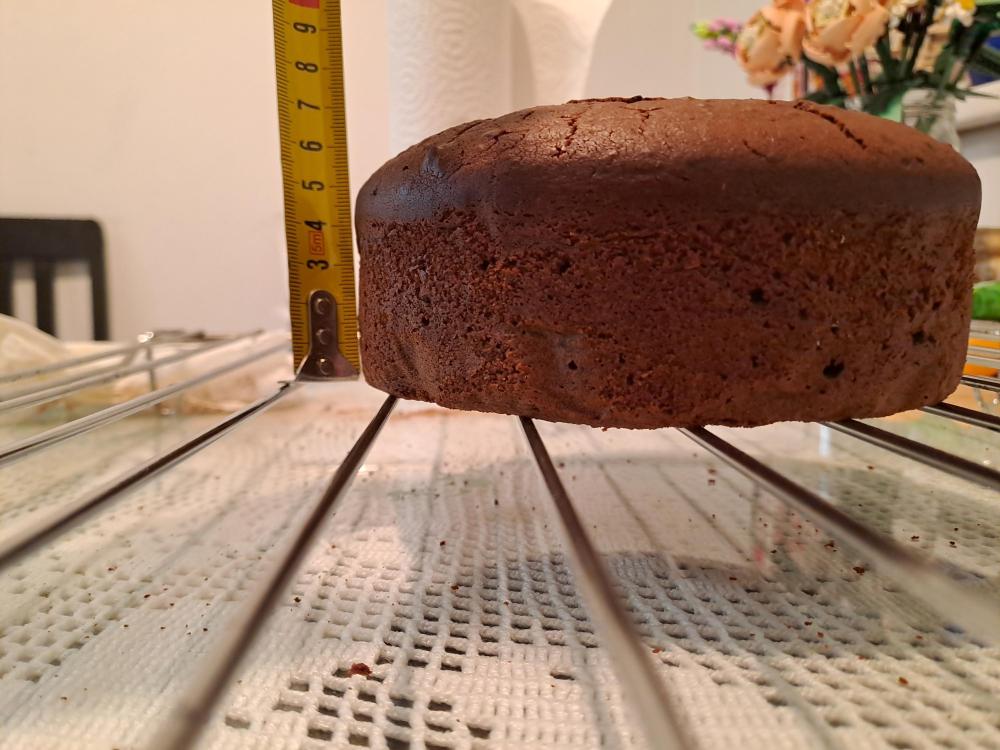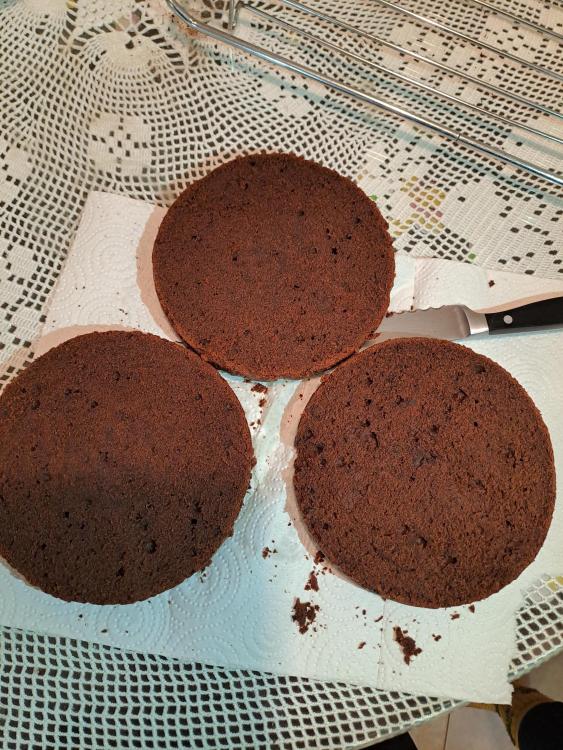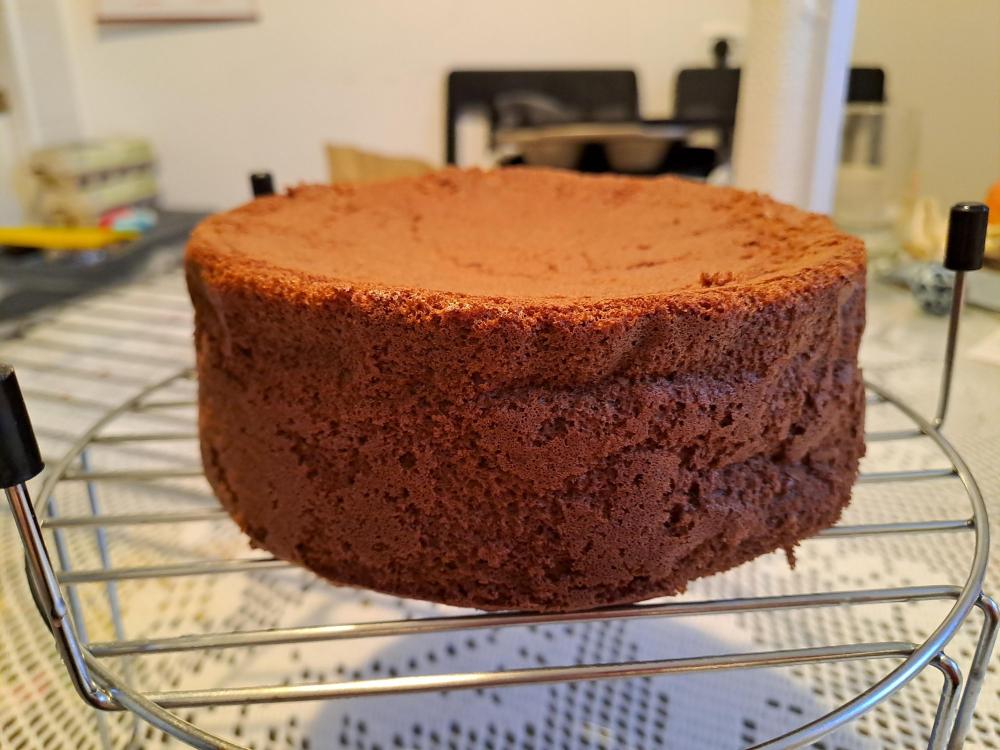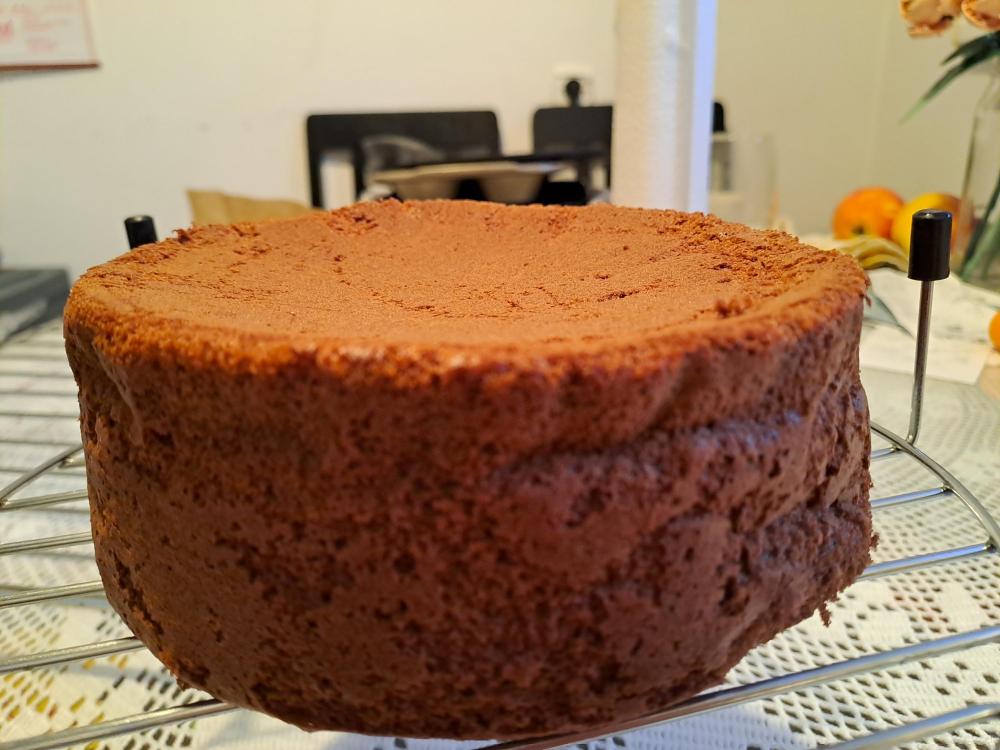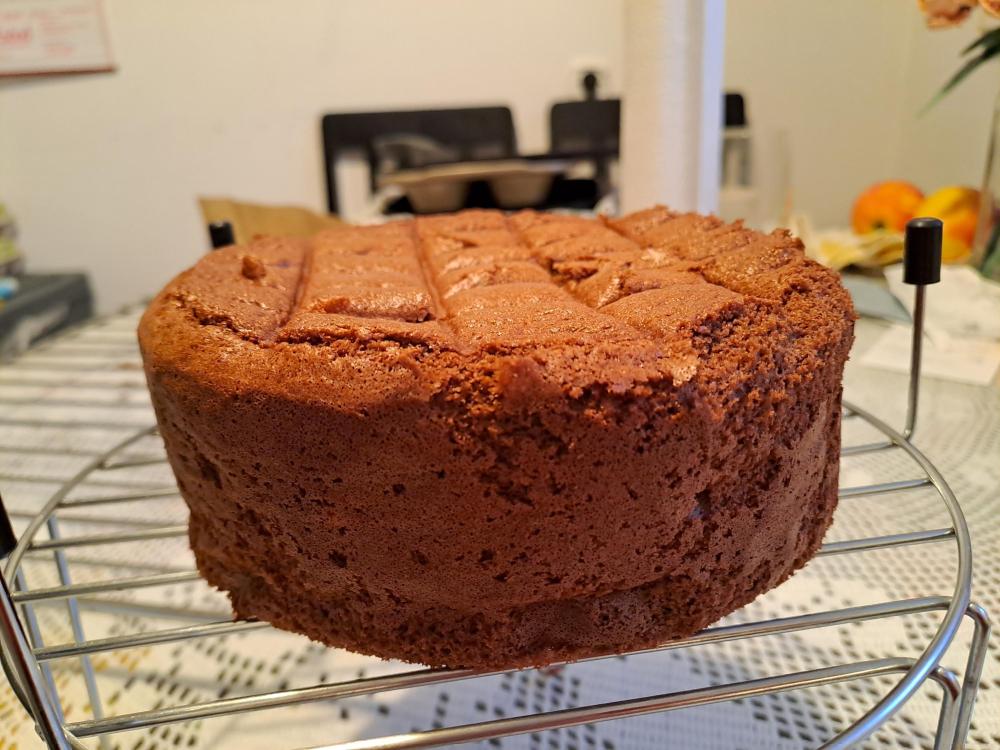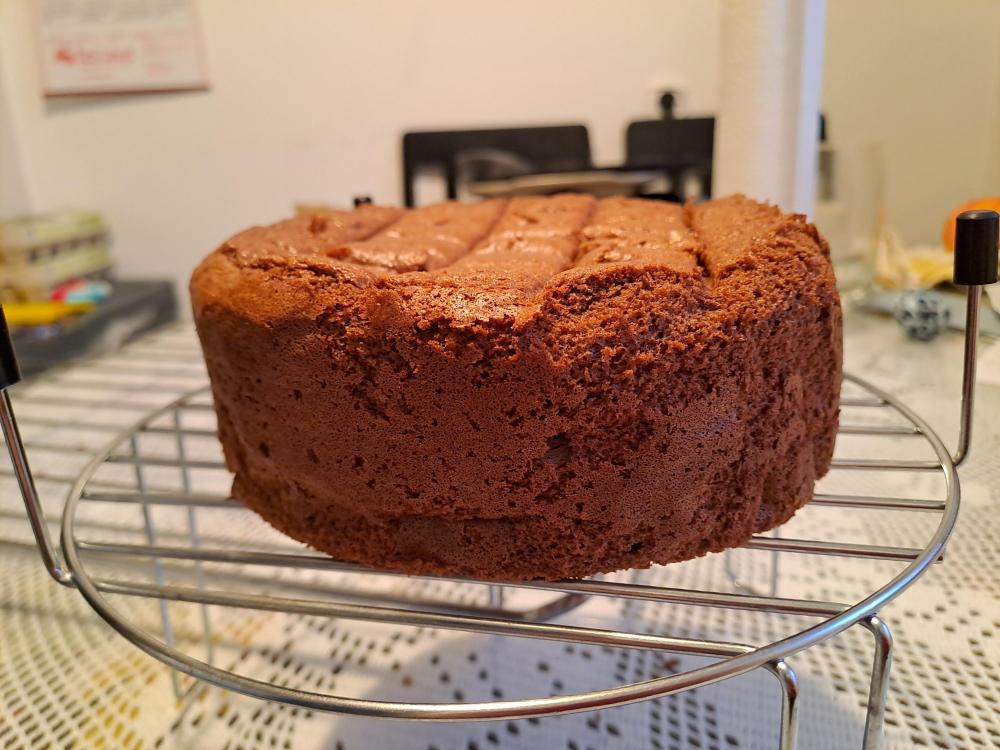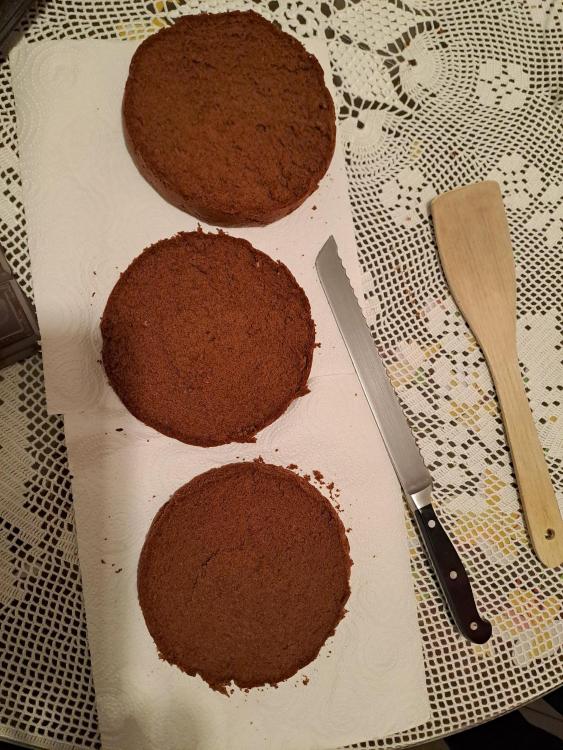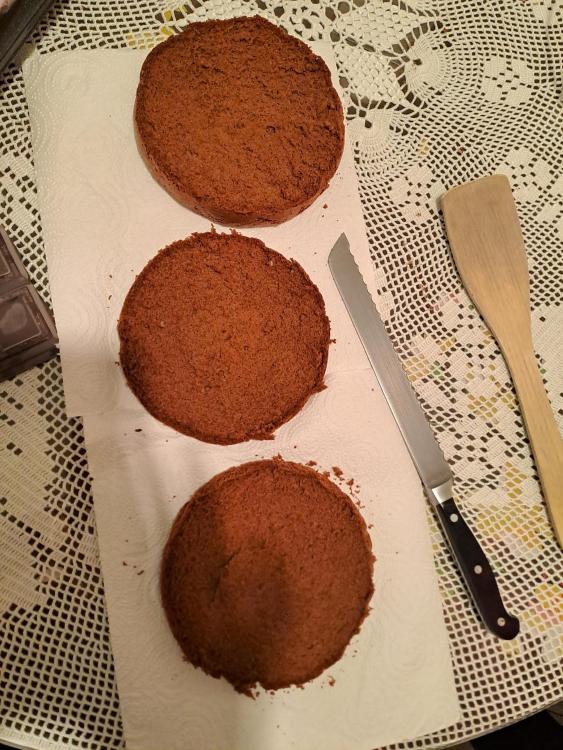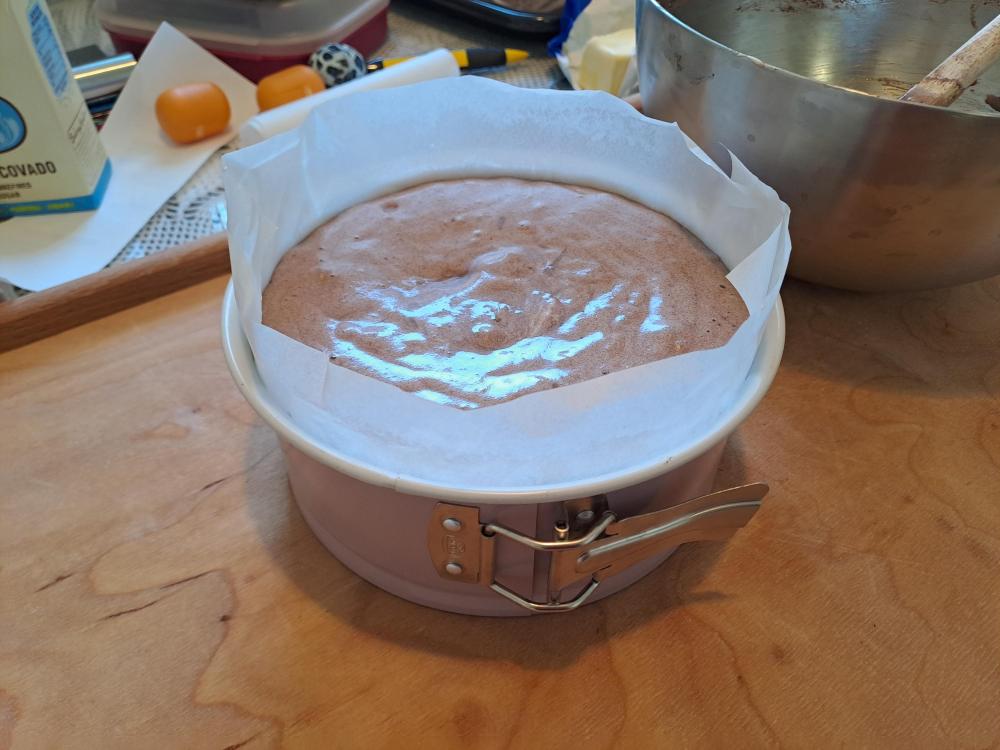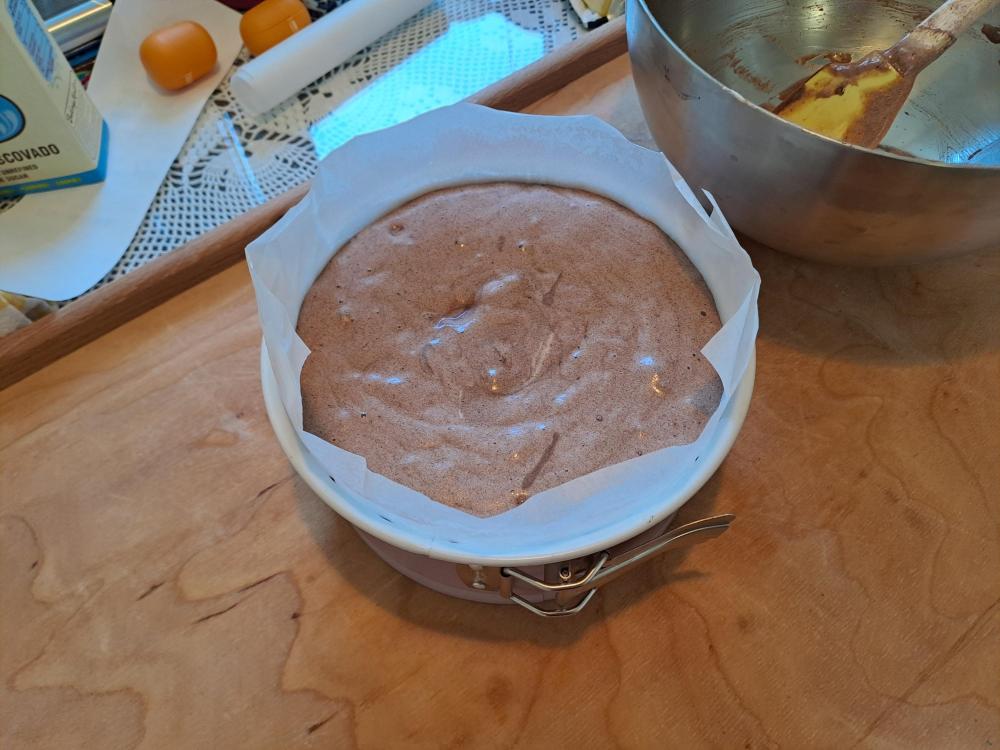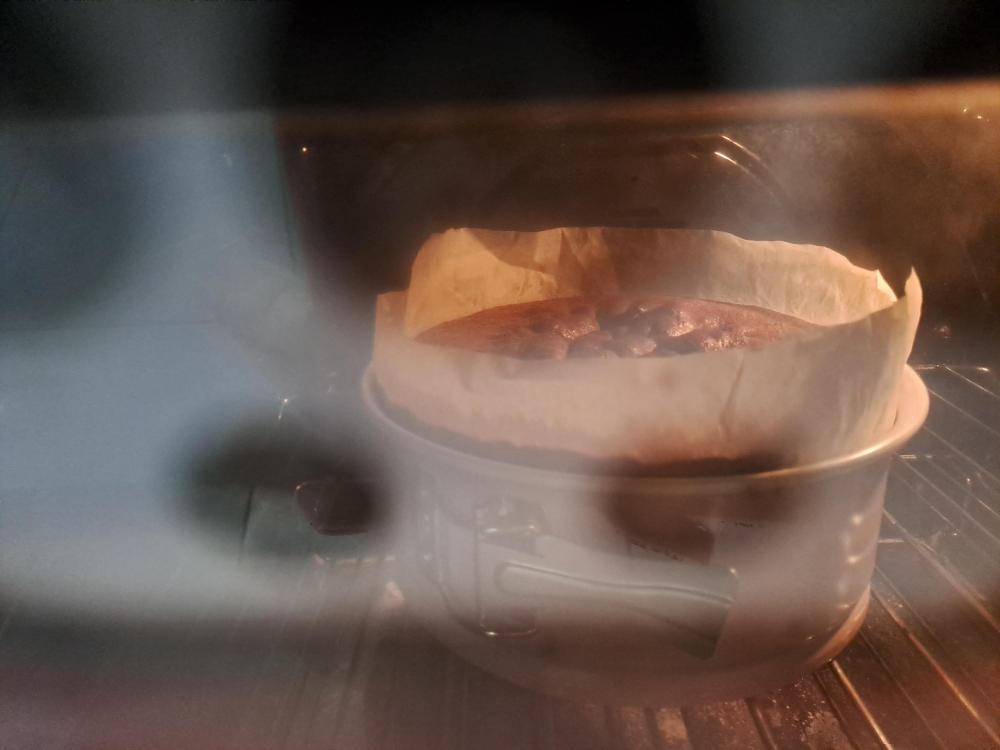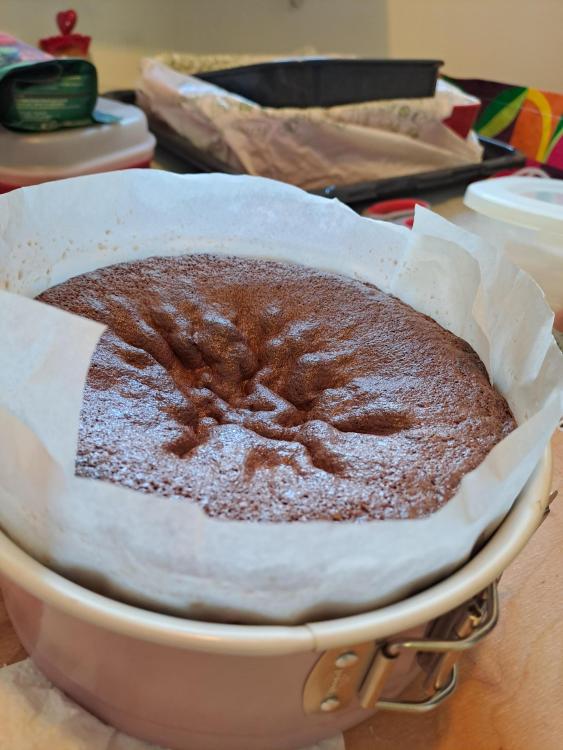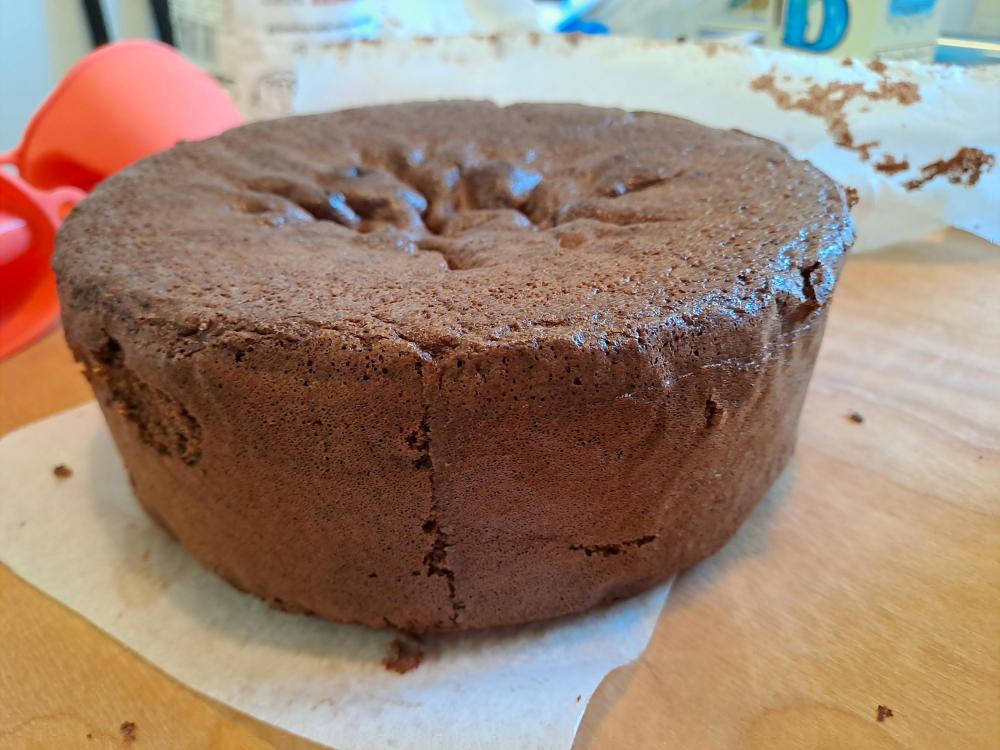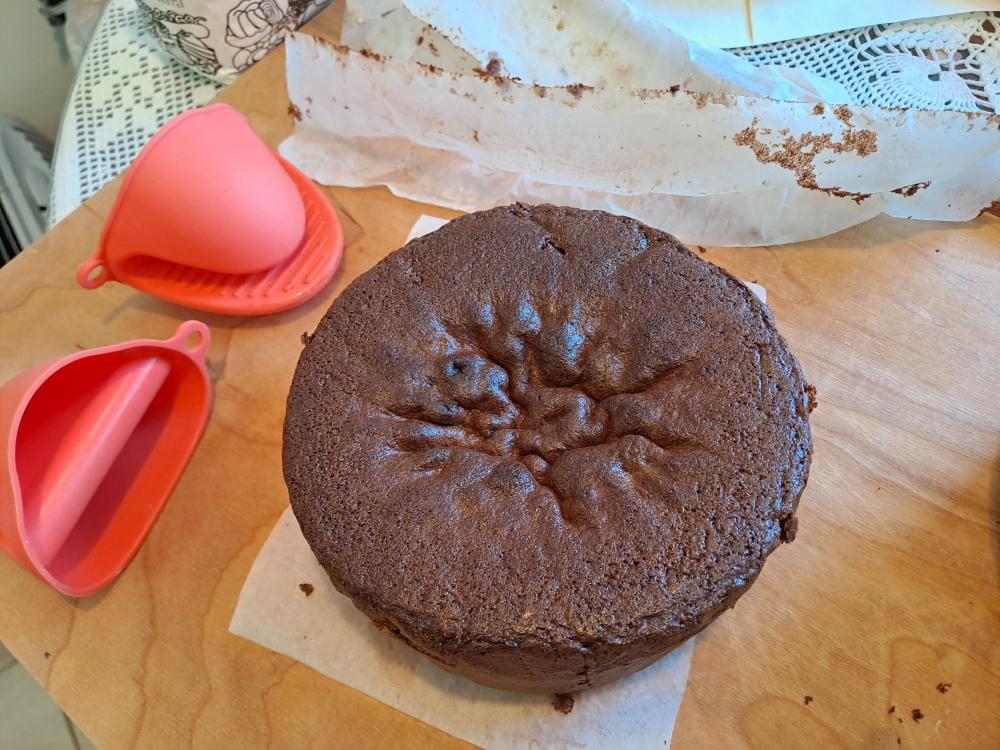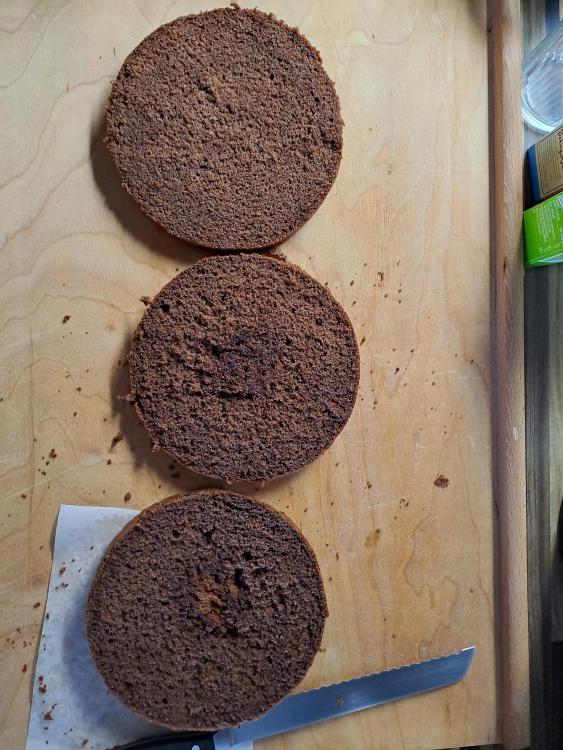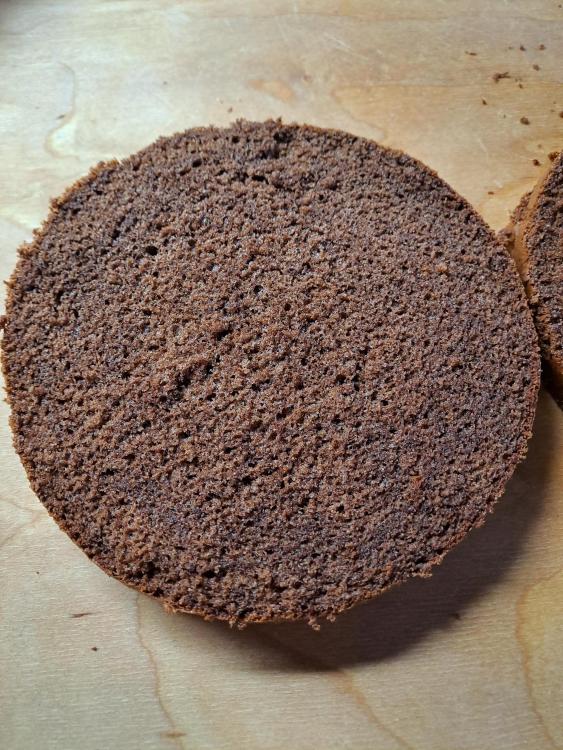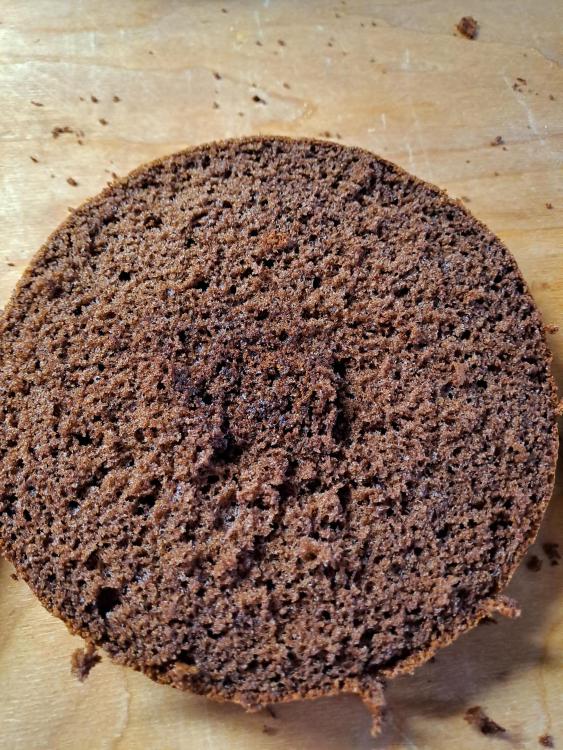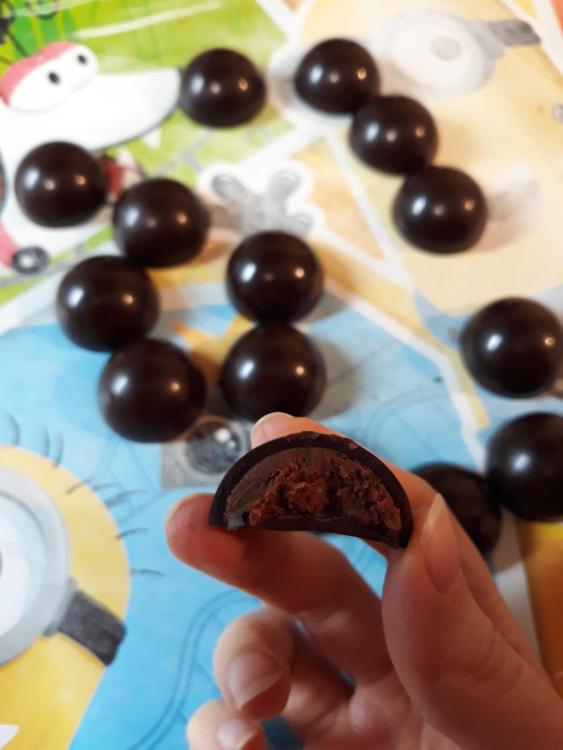
Yoda
participating member-
Posts
31 -
Joined
-
Last visited
Content Type
Profiles
Forums
Store
Help Articles
Everything posted by Yoda
-
I made 2. Forst one was the test one, amd the second one i used my mother was very happy and everyoneloved it, so success
-
Lol, no wonder my cake came out dense I scaled the recipe to fit 6" pan. I cca halved the recipe and baked all at once in the 6" pan. I had to bake for a bit over than an hour. This is the result It's a shame they didn't describe how the texture of the cake should be. The cake came out very dense, but rich in flavour. I like it. I had to add a bit more milk than in recipe to get a "droopy wet consistency" like instructed. I skipped the chocolate chips (although I see some chocolate spots in the cake - not sure what that is?? If anyone knows? The chocolate was completely melted when i poured it into the batter (76% couverture chocolate)
-
Another day, another attempt.. This time I decided to go woth the Genoise au Chocolat from The Cake Bible. (I opted for new recipe because of failure at previous attempt + I didn't like the overwhelming taste and smell of honey...I wanted a chocolate genoise :)) I scaled all ingredients to fit a 6x3" pan (and used 6x4") instead of 9x2" as instructions required (because I don't have that size pan). I lined the pan with parchment on bottom and sides. I also lowered the temperature to 325F (165C) with convection and baked around 32 min. Now I'm thinking I should have gone for at least 35 or 40 min. But the smell indicated to me that it was done, and when I inserted the toothpict it came out clean, so I decided to not return it to the oven. I think the center collapsed ever so slightly after a few seconds and after I gave it a gentle drop. I flipped it over onto a rack and I was a bit clumsy and so had to really pull at the parchment paper to get it off the cake. This is how it looked upside down - you can see a slight indentation... I guess I wont know how it turned out until I cut it. I turned it back to the right side up after cca 8 min, and you can see the cake did collapse a bit..I just hope it's not terribly underbaked in the center🤞 Section pictures: The bottom again was a bit more dense, the middle was soooo fluffy, so was the tip, but the top WAS a bit sunken in. While this didn't turn out as I idealy would have wanted, I think I'm happy with the result. I've noticed the sides look a bit dark but they didn't develop a crust, so I'm not sure, is that only caramelized sugar? What can I do to get a more beautiful top/ not sunken in (the toothpick was dry when I took out the cake) I did use a realy wide bowl when folding in the flour - I think it might have been a bit too large and the cream deflated a bit more than I'd have liked - is this possible? It wasnt teribly deflated though, so I was really, really hoping it wouldn't collapse this time. I'm not even sure how much it rose while baking, if at all?? (Hard to remember since I used such a deep pan) Will post additional pictures of the sections. What do you think of this attempt? Edit: I mesured the height because it looks a bit taller in the pictures. It's at 5 cm (cca 2"?)
-
I tried my first attempt at a chocolate mousse. The chocolate seized after I added a little portion of the pate a bombe to it - not sure where I've gone wrong :/ I was following this recipe, which to me looked very promising. I halved the portion, so I used: 3 egg yolks (24 g) 100 g dark couverture chocolate (which was so sadly wasted...) 30 g heavy cream for pate a bombe (which was also my first time making it) 30 g granulated sugar 225 g heavy cream (for whipping) I started by putting the chocolate in a bowl over boiled water (off heat) and stirred it a bit every now and then. The I put the 30g cream and 30 g sugar mixture on the stove and let it boil for a bit. I slowly poured (very thin stream) this mixture into the egg yolks while whisking with a balloon whisk. The eggs didn't curdle, so I proceded to warm up the mixture over the stove, while constantly monitoring the temperature of it with a probe thermometer. The temperature was around 65 - 67C (cca. 150 F). I did this for about 2 min. I'm not sure the mixture got any thicker though - was this a mistake? And I was only whisking gently with a hand whisk. With a handmixer at max speed, I beat the mixture until the pot no longer felt hot anymore. When I felt it with my hand it felt like body temperature. Here is where I made an obvious mistake - but still unsure to which instant it played a role in the seizing of the chocolate. The video says the PAB should not be too cold (mine felt a bit cooler than body temp) so I left it above the water which previously was melting the chocolate (cca. 15 min later), so I didn't think the bottom would get that hot :/... Meanwhile I whipped the heavy cream to soft peaks. I felt the chocolate, it was about the temp of body temp. Then I stirred the PAB that was sitting over the hot water - the bottom didn't feel too hot, but I did notice some chunks at the bottom of the pan, and it seemed like there was still some egg yolk that was really runny at the bottom... I was pretty sure there was no runny yolk after I had mixed it. Do you think the yolks might have curdled a bit and made the yolk runny? Or maybe I haven't mixed it well enough at all in the first place? I thought I might as well try anyway, so I took a spatula and poured a bit of the PAB into the melted chocolate. As I started mixing, it started seizing more and more ... I knew there was no coming back and I was left with a chunk of very sad seized chocolate.... I threw away everything but the whupped cream which is waiting for my second attempt in the fridge. Where did I go wrong? I would be grateful for some more details on what the temperatures should be (measurable with a thermometer) of the PAB, chocolate and whipped cream. Also, is it correct to add the PAB to the chocolate, or would doing it the other way around be better?
-
I just noticed your post after my genoise topic was merged with this existing genoise troubleshooting topic. By the looks of your pictures, it seems like I have a similar issue to yours (+ my bottom layer was more dense than upper layers). Mine also sunk in the middle (this is my post). As I was reading your posts I think I understand the problem in your case was only you needed to fold in cocoa powder separately (mixed with water) and it turned out good? I'm a bit confused by the temperature - you lowered it despite having a sunken middle? I thought if a cake falls in the middle l, the temperature is probably too low? In the end you baked at 325F for 50 min - is this without convection? I baked mine at same temperature but with the fan setting on
-
Update: I bought one 15x10 cm pan and one 20x10 cm pan. I hope I will be able to bake the whole cake in one 20x10 cm instead of two 20x7 cm pans (maybe I'll make a bit less batter). Any ideas how to adjust temperature or time if baking if there's more batter?
-
Hi, I'm very new to baking cakes and need a little help deciding what kind of pan to get. I found a store that sells (PME) anodised aluminium cak pans with removable or solid bottom and of different heights for the same diameters. I was wondering which height should I get? 1. If I get a pan with higher sides, could there be a problem while baking if my batter only fills a third or half of the pan? 2. If a recipe calls for two pans to bake cakes in, could I just use one pan with sufficient higher edges to bake one high cake and then cut it into two layers? Or will I increase the risk of cake sinking,baking this way? (I'm refering to this recipe in particular - seems a bit of a waste buying two identical pans, but am willing to if I have to) Would I have to adjust the temperature and baking time baking this way? 3. Is there any reason to opt for either the pan with removable bottom or solid one?
-
I'm from Slovenia so the flours differentiate by type (400, 500, 800), the higher the number, the more whole grain it is. And by soft and coarse - with soft flours being more appropriate for leavened doughs and coarser ones for cookies, crepes, pies, etc.(supposedly- that's what the instructions state :)) My flour was type 400, but I opted for the coarser mill instead of powdery like (like the 00 type in italian flours) Going with the coarse one was the mistake probably, along with not diluting it with starch? The thing is, I have a manitoba 00 flour which is veery soft and powdery, but it is meant for baking bread and so has 13% protein. I think I will go with the AP flour and add to it some starch like others suggested. Ap flours here have around 11% protein so it shoul work, hopefully So you guys think it was the flour? Edit: Do you think the temperature was appropriate? (I'm always confused with baking, when the recipe says to bake at a certain temperature - is it meant to bake at that temperature with or without fan? .. And since I have the option of baking with fan on, should I lower the temperature of baking and vy how much. For this recipe though, I think the instructions were meant to bake with fan, since the instructed temperature was 165C. While I was looking qt a lot of other genoise recipes, they all said to bake at 180°C (so I'm guessing that was meant without the fan on?)
-
Yes, oopsi :) But it was the only honey I had at hand. And I really didn't think the small amount would take over the cocoa flavour x) the kitchen, while baking, smelled like I was making gingerbread lol
-
O my gosh, I didn't even think of trying to find a cake flour substitute (or that it was even possible). Thank you so much, I'll definitely take a look at the link you've posted! (Though I'm still not sure whether I should use the smooth or coarse flour as the main flour... I'm thinking I should have gone with the smooth one since the crumb was kind of crunchy here and there - similar texture to a pie)
-
That's exactly why I wanted to use the 76% one instead of buying a new one I also thought the taste of it was going to go well with the cherries, but really wasn't sure if the fluidity makes a difference when making the ganacheganamostly used this chocolate to make shells for bonbons. I made a trial genoise today, my first one ever, and it wasn't the greatest success- the taste was really prevalent in honey, so I'm hesitant of making it as I'm not sure it would go well with chocolate ganache and cherries? You can't taste chocolate/cacao at all in it I wonder if the honey I used (chesnut) was maybe too strong. I could already smell only honey while it was baking
-
Hi all 👋 I made my forst genoise today (or at least attempt to). I was following this recipe. Sice I only had a 18x7 cm pan, I increased all the ingredients by factor 1,4. Ingredients: 217 g eggs 123 g sugar (regular, krustal, white) 14 g honey 84 g flour (not cake flour probably) 25 g starch 18 g cocoa powder 38 g butter (melted) I followed the recipe precisely (only my butter was melted and waited at room temperature not at 40-50C like recommended in the video). Firstly, my ribbons while beating egg, sugar and honey mixture were really priminent - is there a thing as overbeating the batter? Secondly, I noticed my oven temp was 160°C (with fan on) instead on 165°C as recommended- this mistake I know i made - is 5°C dofference big enough to cause the genoise to nit rise at the middle? And ine more thing - the very important one - here in Europe, we don't have names for flour as in America and maybe some other countries. Here we have soft/smooth flour (like manitoba 00) and coarse flour that isn't ground that mich to a powder consistenci, but rather a tiny bit less. I read that cake flour is supposed to have between 5 and 8 % protein. I was choosing a flour for a long time..in the end I got the coarser flour and chose the one with least protein I could find. It has the folowing characteristics: Fat: 1% Carbohydrates: 72% Protein: 9,8% Fiber: 2,3% Was the flour a bad choice? Here are some pictures of the genoise: Batter when poured into the vake pan Whilebaking in the oven (first 5 minutes) After 30 min I checked on the genoise (the smell was hinting it was ready) and when i inserted a toothpick in the center it came out clean. So I removed it from the oven after 30 min. This was the result Here are pictures of sections: Bottom section Middle section Top section All the layers side by side (bottom left to top right) Btw, the honey is very prominent in smell and taste (a bit too honey-y. I used chesnut honey). The bottom section was most dense and probably wouldn't break easily (not as spongey). The middle one was very light and not dense at all - it had the most pleasant consistency and structure in my opinion. Plese share your opinions with me - where did I go wrong?
-
Hello, I'm mostly a lurker on this forum (reading mostly), trying to learn as much as I can while being a hobby baker. I've mostly been making chocolate bonbons, but have never made a cake before. I would like to make this lovely cake by one of my favourite pastry chefs - Chef Hanbit Cho. I would kindly ask you for help as I really would love to make this cake for my mother's birthday, which is coming up next week, and I have a few questions. Chef Hanbit explained a lot in the video, but I still am not sure whether I can make this cake (and achieve complementary taste with substituted chocolate). Chef used Callebout 2815, which is 57% cocoa solids and, from the description on Callebout site, the taste is supposed to be a bit sweet. I atm have about less than a kg of Cacao Barry's Equateur dark chocolate which has 76% cocoa solids and is on the bitter side. It also has around 44% fat and is high fluidity. Firstly- is this chocolate appropriate for making whipped ganache? Secondly - do ypu think the high cocoa content will still be complementary with amarena cherries? If not, is there a way I can "correct" the taste of my chocolate to get the right flavour (by adding sugar maybe?)? From other chocolates I only have Zephyr (which is white chocolate and totaly useless in this case probably) and Ghana by Cacao Barry which has 40% cocoa solids milk chocolate (not sure of I can mix the two with one being dark and other being milk chocolate) The other question I have, and please don't hold it against me for going slightly off topic, is the recipe is meant for 15x7 cm round cake pan, I have two 20x6 cm round cake pans. I've calculated the amount to be multiplied by 1,5 to fit one of my 20 cm pans. Would it be an option to use both pans to make slightly more batter, filling, etc. and make higher genoise cakes or would one pan of size 20x6 cm suffice? (Seems a bit low for 3 layers with 20 cm diameter). I would be very grateful for your advice as I really would like to make a homemade cake for my mom. Thank you! Edited for typos
-
Thank you both! Especially Kerry for a fast reply I didn't have any syrup (it's hard to get the glucose syrup anyway - only in speciality culinary shops, which are rare where I live x)), so I made the ganache without it. It seemed kind off thin after adding the liqueur so I ended up putting it into the fride after an hour. It firmed up now. I'll have to finish them up tomorrow. Will take them out of the fridge so it comes to room temp and then finally finish by coating in dark chocolate 🤩
-
I would like to follow a recipe for ganache with white chocolate and korsch liquer. I don't have any glucose syrup at the moment, but would really like to make this bonbons today. Is it possible to adjust the ratios so the ganache turns out ok, even if making wihout glucose syrup? Can I just skip the glucose, or do I have to substitute with something? In the end isn't glucose only sugar and won't really have an impact on the finished ganache even if I don't include it? (I'm making them for "home-use" and don't care mich even if it will be stored in the fridge, so I don't have any worries about shelf life) Thank you!
-
@pastrygirl and @Jim D. thank you both for your suggestions. I haven't actually tried shelling with Zephyr yet, but was interested in theory of technique if and when I ever do have to fill the shells more than once (seeing the fluidity is marked as highest on this bag) I only made bonbons for the first time (twice!) this week and while I had some beginners luck on the first try with the shell thickness, they did take super long to release so I eventually put them in the fridge to help them - I read after that, that you actually should put the molds in the fridge when they start to set so as to help the latent heat dissipate and fully crystallize (noted for next time :)) On the second attempt, the shells were soo thin - I don't know whether I was taping the mold to release too much chocolate, or it just wasn't tempered properly, but almost all of the chocolate ran out of the molds. I was thinking about doing another pass, but wasn't sure if it would just make the situation worse since I wasn't sure of the temper anyway. So I decided to put them in the freezer to get them to release finally - luckily only 1 of them was a stubborn one that just wouldn't let go so I had so wash that one out with warm water. The shells were so thin, some broke when I was taking them out. Following is a bit counter-topic, but I wanted to share: After that I said to myself, okay, better to leave the chocolate in the mold for longer so it actually forms a shell. So I left the chocolate to sit for about a minute (took me a while to fill and tap the bubbles out, so maybe 2- 2,5 minutes overall). After that I turned the mold around and no chocolate was flowing out! I immediately started tapping the sides but a lot more chocolate remained in the mold than I was hoping You can see the thickness here: (p.s. I'll have to search how to resize the pictures so they aren't so big) Which I don't think looks that bad? (probably one of the "thinner shells of this batch") But the bottom parts were really thick and some of them had only tiny cavities for the filling. I'm guessing I also over crystallized my chocolate as I was struggling to get it in temper. I failed the capping a bit too as the chocolate started to set before I managed to scrape it off + I saw some leaking? You can see on the picture below the thickness of the rings around the caps But overall it was fun. Now to just get the tempering right...is it true tempered chocolate sets in a few minutes??? I usually dipped the end of the knife but it showed a fingerprint when I touched the chocolate after 2 min (maybe even more) - maybe my hands were already so warm from stirring and the ambient temp was around 24C, or am I just trying to make myself feel less of a failure?.. the chocolate seemed to set and didn't look like it had any white spots or streaks, it just took a lot longer.. I'm getting really off topic so I'll wrap it up by saying that no matter how much (very highly appreciated might I add!) advice you get, it's also about the tries and failures (and hopefully some more successes, hehe) that teach you a lot! theory and practice are waay different matters. Now to convert all of that advice into practice!
-
Hi, I know I'm waking up an ooold post, but this is what I was searching for. I have Zephyr by Cacao Barry and it's fluidity is really high. I don't have experience in molding with high F chocolate. I once made my shells too thin by inverting te mold too quickly and I had to put the mold in the freezer to get the shells out. How do you go about making 2 layers when shelling? Would you mind explaining the procedure (or anyone else that know how to do this)? Do I wait for the first coat to set, or probably just so it sets a tiny bit? And then add another layer? I was thinking since the chocolate contracts and that's what makes it release from the molds, I probably shouldn't wait too long in between layers so it can contract more evenly? Hope my question made sense. I really want to try the white chocolate but I feel a bit intimidated by the high fluidity of it
-
Lol, as a non-native eng speaker I don't understand exactly what 'burning a swath through' means (google wasn't of much help) but I can only imagine and it sounds extreme lol - in my mind I imagine an electric arc 🤣🤣 I'll take this as a consolation to being stuck with the double boiler method, and not having a working microwave atm then x).. Well, I guess I'll be trying making some chocolate caramel in the near future Thanks for explaining some stuff
-
That's why I was confused why you should never heat chocolate above 45 or 50C. I know, and that's why I felt silly asking the question, but since 'don't overheat it' or 'chocolate burns so easily', etc.came up over and over, I kinda started scratching my head on the subject lol. So chocolate doesn't burn as easily as everyone a lot of people say? I think I'm going to have to read a thing or two about Millard reaction too x) I must admit though, it still sounds strange (to me) to add chocolate to 114C caramel (from everything I've read and heard)..I guess it really doesn't burn as easily..
-
Not sure if this is the right place to post my question, but I didn't want to open a new thread since mine is also a ganache question, so here goes: When making ganache - how come the hot cream doesn't burn the chocolate? I know this might be a silly question, but I was wondering, if you have to be so careful not to heat chocolate beyond 45°C or so so it doesn't burn, how come the high heat from the cream (when making ganache) doesn't cause some of the chocolate to burn? Surely some of it gets heated beyond 45°C in the process, doesn't it (especially if making 1:3 chocolate:cream)? And I'm asking because I wanted to try and combine ganache with caramel, and wasn't sure how to go about that - should I cool the caramel to 45C and then add chocolate, or should I pour the caramel over the chocolate when it cools to lets say 70-60C or so? Or maybe I could try melting chocolate to 45 and mixing it with caramel at 45?..now that I'm writing this down, the final approach seams the most reasonable, right? To add even more confusion (to myself, maybe it's all clear to you xD) - I went through the chapter for caramels in Moratos book, and there I found my answer when to add chocolate (114C) which is beyond the temperature I'd ever dare adding it - wouldn't this burn the chocolate?? I mean, if it's in the book I completely trust and accept it wouldn't, but I'm struggling to understand why. Similarly to when caramelizing white chocolate - wouldn't that be 'burning chocolate' in a way too? What's the difference between caramelizing and burning if caramelizing takes place in the oven at 120°C while it burns already at 45°C (or even sooner for white)? If anyone would care to explain, my perplexed mind would be ever so grateful
-
Third's a lucky charm xD hehe
-
It's 35% fat (the usual I guess). Whatever it was, I'm glad adding water and reboiling solved the separation and the undissolved salt x) Not sure either, I followed the recipe that called for room temp cream. But I've seen some videos of chefs bringing the cream to a simmer before adding to caramel also (I wondered why some heat others not, but hadn't really dug into it yet..maybe as an assurance to prevent it from seizing? Or maybe it's just a matter of preference and habit). After reading all the possible reasons for separation, it might have been either the temperature shock from using a thin pot for reheating or humidity from using a double boiler (with bottom of pot submerged). Who knows.. But since the separation happened days later, only after cooling from reheating - I think I should be fine next time if I add the salt in when I pour in the cream (fingers crossed). And to be on the safe side, I'll use an immersion blender next time if I make a large enough batch x)
-
It couldn't have been butter because I didn't add any, but it could have been fat from the cream? I added sugar and a bit of water, melted and heated to dark amber colour, took it off the heat and poured about 1/2 of the room temp cream in, stirred well and added the rest when the bubbling slowed down, stirred and transferred until cooled. And it was all good until I heated it back up today - the separation surprised me after coming back to check on it to see if it has cooled down -.- I've read the whole story, in the thread I linked to, about your pineapple puree endeavors. I didn't know this was even a thing. Every recipe/video I've seen on making caramel made it seem so easy - and I was so pleased when I managed to actually make it. A few days later I thought I'd add in salt and bam I learned something new - that separation could happen. But I'm still not sure I understand what caused it in mine, since it was homogenous before reheating. Do you blend while it's still hot? Have you ever tried it after the separation already occurred? I wonder if it would work if you heat it back up and blend. Edit: After getting back to the comment on salvaging separated caramel (from pastrygirl) I see this is exactly what pastrygirl alredy suggested - using an immersion blender after bringing back to boil (it must have clung to my memory in the background x)) but just slipped my mind when writing this comment. I didn't use an immersion blender after boiling because I had such little amount of caramel it wouldn't even have been possible. In the end I did as @pastrygirl suggested in the linked post. I added water and brought it back up to boiling. That did help so thanks pastrygirl A veery thin layer on top remained after cooling down - not even layer as much as some droplets but it fixed it to the point I'm ok with it. I didn't know further cooking would darken the color also - I thought that only happens when there's so little water in the caramel that it reaches way higher temperatures.. Oh, I think the salt has dissolved nicely when boiling for a minute too. I might not mind the grains of salt that much also, I just wanted to get it all melted since that was my plan so I guess it was a matter of stubbornness
-
Edit3: just found a post with identical issue to mine ( ) sorry for posting too soon x) Need help please - caramel released water? I made caramel a few days ago - was a success, creamy, smooth caramel (sugar, water, cream). Today I decided I wanted to add salt to it, so I heated it up and added salt. The thing is, the salt hadn't dissolved properly, and I'm not sure why? Any ideas? As the caramel cooled down, I was left with really gooey caramel and found a layer of liquid when I tilted the pan. I heated it back up and whisked it back together so its a saucey consistency once again, but I'm afraid it'll just separate again once it reaches room temperature. Is it possible to add salt after already adding cream and cooking it back up so it thickens a bit, ir is there not enough water to dissolve the salt at that point? Can I do anything to save it if it separates again? Edit: yup, it's still there.. looks like condensation on caramel Edit2: oh no, no that I'm reading about caramel everyone is so cautious about the humidity?.... I was firstly heating it in a thin pan, and it seemed like it was heating too fast so I decided to use a double boiler method (but with the bottom dunked in the boiling water, to not let it go above 100C)...this might have caused it? I'm still struggling to understand though, why it absorbs water and melts nicely after heating up, but then starts to separate? There must be some sugar chemistry reason behind it that I don't understand (I would love to though if anyone could explain)
-
Haha, I guess since they're (apparently) so trendy, maybe they didn't think there were people like you or me left, that hadn't heard of one and seen one in action From my experience (drinking the 3 reindeer musketeers),the milk has to be really, really hot, then you have to stir vigorously for some time until it's all melted (maybe it will melt faster for you if it only contains powder, mine had a firm ganache and caramel from the fridge + bitter cocoa powder inside). Or I suppose you could wait for 3 or 4 min to let it soak and melt and then give it a good stir The "mistake" I made when making them was I put too much filling inside a single bomb (too sweet) so I had to melt mine in 0,5 l of milk (in a high pot) and divide into two mugs after everything has melted x)




